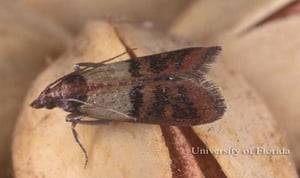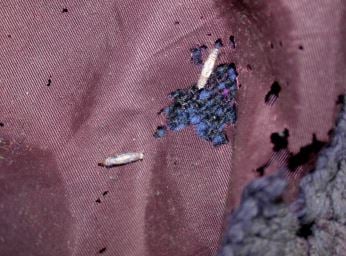Monitor and Prevent Moths in NJ & PA With Cooper
 You might be wondering, what is a moth? Why do I have moths in my home? What attracts moths to my home? You may encounter different types of moths in New Jersey and Pennsylvania. You've probably seen moths flying around outside, looking very similar to butterflies with their ability to fly. Unfortunately, moths are also known to be household invaders, attacking pantry items, clothing, and rugs.
You might be wondering, what is a moth? Why do I have moths in my home? What attracts moths to my home? You may encounter different types of moths in New Jersey and Pennsylvania. You've probably seen moths flying around outside, looking very similar to butterflies with their ability to fly. Unfortunately, moths are also known to be household invaders, attacking pantry items, clothing, and rugs.
Moths vs. Butterflies
What is the difference between moths and butterflies? This is one of the most commonly asked questions when moths are first being seen, whether they're indoors or outdoors. The best way to differentiate moths and butterflies is appearance and behavior. There are tens of thousands of species of butterflies and moths worldwide, but there is one characteristic that stays fairly consistent between all moths and all butterflies. The easiest way to differentiate a moth from a butterfly is by the appearance of their antennae. Butterflies have slim antenna with clubbed tips and moths have fuzzy, almost feather-like antennae. The second most defining characteristic that separates moths and butterflies is the position of their wings when resting. Butterflies can be seen resting with their wings up vertically where as moths rest with their wings down, often clamped around their body like a protective shell. Butterflies are most active during the day while moths are most active at night.
If you spot one of these flying pests in your home, it's most likely a moth. Butterflies do not infest homes or reproduce indoors. For that reason, if you happen to find a butterfly in your house, it's because they wandered in by accident. As for moths, your home can be an ideal breeding ground. They have access to your clothes, pantry items, upholstery, and more, making it easier for survival than living outdoors. Although there are numerous species of moths, clothing moths are the most common and most targeted by pest control professionals.
Webbing Clothes Moth

Description: The webbing clothes moth is the more common of the two types of clothing moths. Adult webbing clothes moths are about ½ inch long, wing tip to wing tip, and about ¼ inch when its wings are folded. The body and wings are a yellow/gold color and the head is covered in red/brown hairs. A mature larvae is a ½ inch long caterpillar with a clear to creamy-white colored body and light brown head.
Signs of Activity: Adult webbing clothes moths are rarely seen because they avoid the light. It's not uncommon that people typically do not know they have an infestation until damage becomes apparent. You should keep an eye out for holes in clothing, rugs, carpets, felt, upholstered furniture, and stored wool.
Control & Prevention
- The most effective way to prevent infestations is regular thorough cleaning.
- Female sex pheromone traps (trap containing female scents that lure in male moths). These traps are a helpful tool in monitoring any increase or decrease in a moth problem, as well as indication locations of high activity.
- Vacuum rugs & furniture regularly as well as in areas that typically wouldn’t be cleaned like behind a sofa or wall decoration.
- Any infested article should be thoroughly cleaned to insure removal of any remaining larvae.
- Because moths are especially attracted to clothing worn less often in dark corners, try to rotate the clothing in your closet every month to prevent an infestation hot spot.
- Be sure to store any clothing of natural fibers and seasonal decorations in sealed containers when they are not being used.
Casemaking Clothes Moths

Description: Casemaking Clothes Moths are small moths that can infest and destroy a wide range of textile materials such as woolens, feathers, felts, skins, and furs through their feeding activity. This type of clothing moth is smaller and less common than the webbing clothes moth. An adult is about 3/8 – ½ inch from wing tip to wing tip. Similar to the webbing clothes moth, their wings and body are a golden color, however they have a brown tinge and three dark spots on their front wings as well. Unfortunately, these distinguishing marks are often “rubbed off” as the scales on the wings sluff causing the wing pattern to begin disrepair. The larvae are 3/8 inch long caterpillars with a dark head and dark brown or black thoracic segment (leg bearing segment). The larvae live in a small portable case they make out of the silk and the fibers they are feeding on. This silken case is carried around with them as they feed and everywhere else they go while in their larvae state.
Signs of Activity: Like the Webbing clothing moth, Casemaking moths are rarely seen because they don’t fly often and are very secretive spending the majority of their time in dark, protected, environments. Look for holes or signs of feeding on stored tobacco, woolens, feathers, rugs, felts, skins, furs, taxidermy mounts, spices, drugs, and products of plant origin.

Pictured Above: Casemaking clothes moth damage and larvae Photo Credit: University of Wisconsin-Extension
Control & Prevention:
- Check for infestation in areas such as air ducts, baseboards, under heavy furniture, or areas where pet hair may accumulate. It's important to pay special attention to areas that are cleaned less frequently.
- Female sex pheromone traps (trap containing female scents that lure in male moths). These traps are a helpful tool in monitoring any increase or decrease in a moth problem, as well as indication locations of high activity.
- Spices, tobacco, and drugs should be stored in tightly closed containers.
- Thorough vacuuming of rugs and furniture as well as in areas that typically wouldn’t be cleaned like behind a sofa or wall decoration.
- Because moths are especially attracted to clothing worn less often in dark corners, try to rotate the clothing in your closet every month to prevent an infestation hot spot.
- Be sure to store any clothing of natural fibers and seasonal decorations in sealed containers when they are not being used.
Other Types of Moths
Mediterranean flour moth

Description: Mediterranean flour moths are often mistaken as butterflies but are much more destructive. An adult is about ¼ - ½ inch long with a wing span slightly under one inch. Their front wings are a pale gray with wavy horizontal black lines, and the back wings are an off white. A fully developed larvae is 5/8 – ¾ inches long with a white/light pink body and a dark head as well as a dark plate behind the head.
Damage caused:
- They are a major pest in flour mills as they feed on nuts, seeds, beans, biscuits, flour, chocolate, dried fruit, and dehydrated dog food
- Adults don’t cause any damage
- Larvae spin silk tubes around themselves that can become so thick they clog machinery
Control:
- Discard infested items
- Clean shelves, pantries and cupboard thoroughly
- Aerosol sprays
- Sanitation & fumigation when in flour mills or other food processing facilities
Angoumois Grain Moth

Description: Adult Angoumois Grain moths are light brown with a wing span of ½-5/8 inch. The back wings taper to a thumb-like projection at the tips and are gray. The back, and front wings as well, are also fringed with long hairs. An adult larvae is about ¼ inch long and has a yellow/white body and brown head.
Signs of Activity: You are likely to see this type of moth because they are attracted to light. You may have an infestation if you notice any moths or larvae on or in decorative Indian corn, popcorn, bean-bag-filler corn, and other whole seeds.
Control & Prevention:
- Discard any infested grain, seed, or caked material
- Infested stored products should be clean, as well as any shelves, pantries, and cupboards
- Infested decorative items should be kept in a freezer for several days to kill larvae & pupae
- Adult moths can be removed with a vacuum or light trap
- Female sex pheromone traps (trap containing female scents that lure in male moths)
How can Cooper help?
Cooper’s Clothing Moth Monitoring Plan

There are 3 different processes to the Clothing Moth Monitoring Plan, and 3 different price ranges that correspond to each process.
- The initial service consists of an initial consultation, inspection, and monitor placement. There is a base fee that covers the initial consultation and inspection, and price for monitor placement depends on how many monitors are placed in the home.
- The monthly service has a base fee for minimum number of monitors (10 monitors) and an additional fee for each monitor above the minimum number. There is also a fee for replacing monitors if necessary, and that will vary according to activity and need.
- After the first 3 months of monthly services, possible treatment recommendations will be made, and this entails a special service which is not covered by the Clothing Moth Monitoring program.


